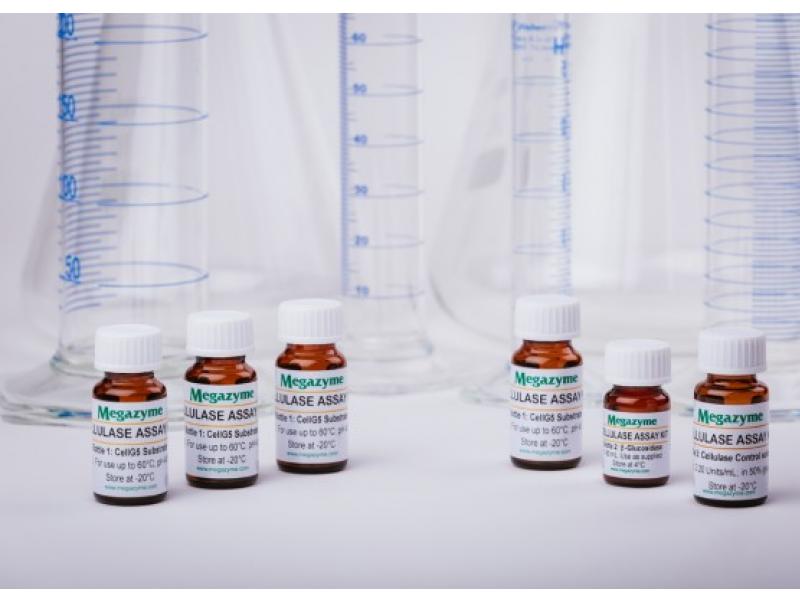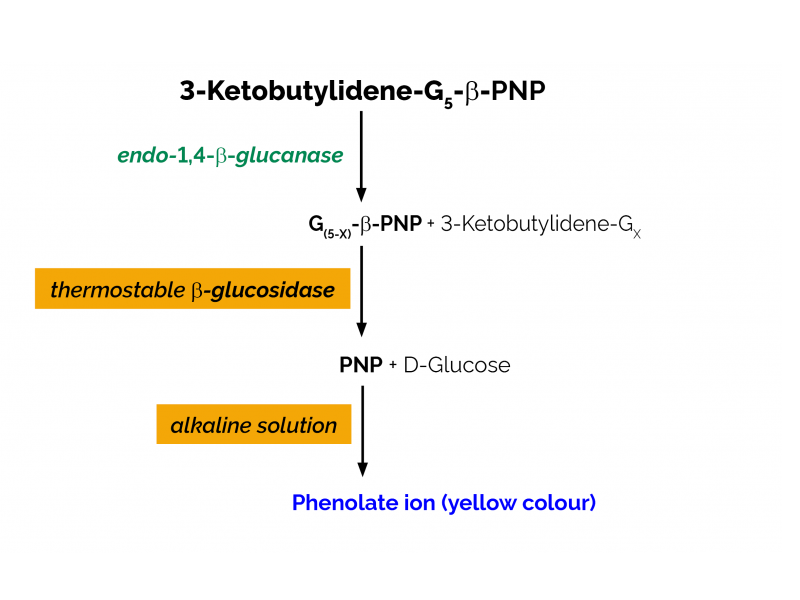Endo-cellulase (high sensitivity) - Enzyme activity assay kit
Reference : K-CellG5
Reagent for the specific measurement of endo-cellulase (endo-1,4-β-glucanase)
Countries eligible for delivery
Countries eligible for delivery:
France (except Corsica and overseas departments and territories), Algeria, French overseas departments and territories, French Polynesia, Libyan Arab Jamahiriya, Morocco, Tunisia, Egypt, France (Corsica)
Reagent for the specific measurement of endo-cellulase (endo-1,4-β-glucanase)
Shipping temperature: ambient
Storage temperature:
- Short term stability: 2-8oC,
- Long term stability: see individual component labels
Assay format: spectrophotometer, auto-analyser
Detection method: absorbance - 400
Signal response: increase
Total assay time: ~ 10 min
Detection limit: 1,2 x 10-3 U/ml
Reproducibility (%): ~ 3%
Stability: > 2 years under recommended storage conditions
The CellG5 assay reagent for the measurement of endo-cellulase (endo-1,4-β-glucanase) contains two components :
1) 4,6-O-(3-ketobutylidene)-4-nitrophenyl-β-D-cellopentaoside (BPNPG5)
2) thermostable β-glucosidase.
The ketone blocking group prevents any hydrolytic action by the β-glucosidase on BPNPG5. Incubation with an endo-cellulase generates a non-blocked colourimetric oligosaccharide that is rapidly hydrolysed by the ancillary β-glucosidase. The rate of formation of 4-nitrophenol is therefore directly related to the hydrolysis of BPNPG5 by the endo-cellulase. The reaction is terminated and the phenolate colour is developed on addition of Tris buffer solution (pH 9.0).
The CellG5 assay represents a huge step forward in the methodology for the measurement of cellulase that traditionally relied on substrates such as CM-cellulose, Avicel, cellooligosaccharides, filter paper or dyed polysaccharides including CMC Congo red or cellulose azure.
Novel method
Shipping temperature: ambient
Storage temperature:
- Short term stability: 2-8oC,
- Long term stability: see individual component labels
Assay format: spectrophotometer, auto-analyser
Detection method: absorbance - 400
Signal response: increase
Total assay time: ~ 10 min
Detection limit: 1,2 x 10-3 U/ml
Reproducibility (%): ~ 3%
Stability: > 2 years under recommended storage conditions
The CellG5 assay reagent for the measurement of endo-cellulase (endo-1,4-β-glucanase) contains two components :
1) 4,6-O-(3-ketobutylidene)-4-nitrophenyl-β-D-cellopentaoside (BPNPG5)
2) thermostable β-glucosidase.
The ketone blocking group prevents any hydrolytic action by the β-glucosidase on BPNPG5. Incubation with an endo-cellulase generates a non-blocked colourimetric oligosaccharide that is rapidly hydrolysed by the ancillary β-glucosidase. The rate of formation of 4-nitrophenol is therefore directly related to the hydrolysis of BPNPG5 by the endo-cellulase. The reaction is terminated and the phenolate colour is developed on addition of Tris buffer solution (pH 9.0).
The CellG5 assay represents a huge step forward in the methodology for the measurement of cellulase that traditionally relied on substrates such as CM-cellulose, Avicel, cellooligosaccharides, filter paper or dyed polysaccharides including CMC Congo red or cellulose azure.
Novel method
- Very cost effective
- All reagents stable for > 4 years after preparation
- Completely specific for cellulase (endo-1,4-glucanase)
- Generally applicable and highly sensitive
- Simple format. Well suited to automation
- Standard included
Fermentation broths, industrial enzyme preparations and biofuels research
Data Booklet
Safety data sheet
Validation report
Data calculator
The attached documents are subject to change. To receive the latest updates, please contact us.
Specifications
| Reference | Packaging | |
|---|---|---|
| K-CELLG5-2V | 60 / 120 tests (manuel/manual) - 240 tests (automate/auto-analyser) | |
| K-CELLG5-4V | 120 / 480 tests (manuel/manual) - 240 tests (automate/auto-analyser) |


